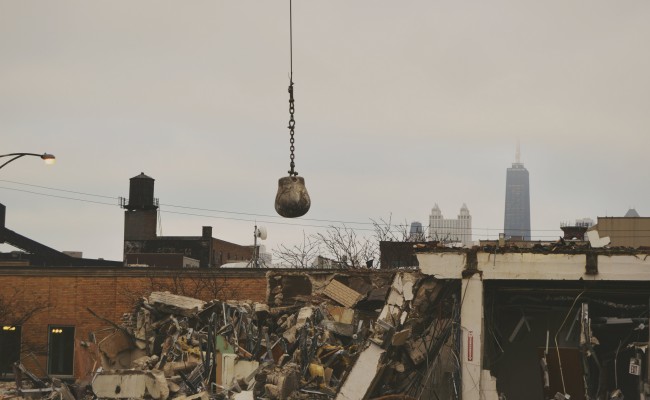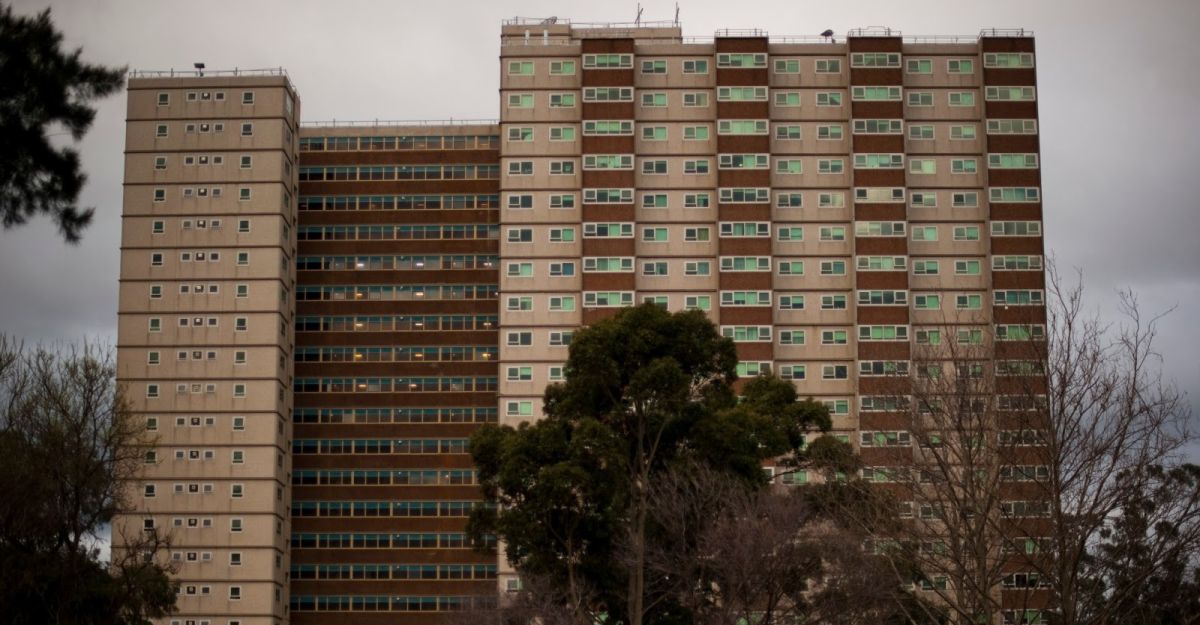The desecration of the Corkman Irish Pub has been met with a community displaying symptoms ranging from disbelief, grief, to searing anger.
Throughout the aftermath of this saga that kicked off when bulldozers collided with a 159-year-history of drink and song, ‘the plot thickens’ has introduced many a sentence. The saga continues to become more strange and terrible by the day.
The following correspondence appeared on the Working Group to Resurrect the Corkman Facebook page a few days after the demolition.
The National Trust received this tip-off today. Anyone know more?
‘Hi there in the Corkman pub there was a leadlight eagle that was supposedly given to robert menzies from lbj when he came to oz in the 60s as a gift to Oz from America thought i bring this to your attention as it might have survived.’
That’s the same Menzies who said, ‘More good things in life are lost by indifference than ever were lost by active hostility.’
Behind the scenes, in concerned community conversations, student lobbies, change.org petitions, Facebook groups, boardrooms, and our state and local politic, interested actors have been sifting through the rubble of the Corkman mess. There is much to parse. The rap sheet of the developers and demolishers looks as bleak as a demolition site. They couldn’t have broken more rules in the book if they’d tried, and that book is about to be thrown at them.
When you demolish a building it comes in handy by law to have a permit. The bureaucracy of the Victorian Civil and Admissions Tribunal can get on peoples’ nerves, but on this matter the law is uncomplicated. This is for any building, whether stables out in the backyard, a dilapidated tenement, or a 159-year-old pub.
Corkman Irish Pub (State Library of Victoria)
And that is just the beginning. A scroll of potential charges including Illegal demolition, building code violations, WorkSafe breaches, arson, conspiracy, failure to properly dispose of dangerous materials and reckless endangerment has been lengthening by the day. All of it shrouded in a mushroom cloud of asbestos, all on a property with heritage overlay protection in the Melbourne City Council’s planning scheme.
This is quite an effort from the developers, who might be starting to have some second thoughts.
There are three broad avenues into any conversation on this debacle. One is the brazen illegality of what transpired. Another is the cultural mourning. And the last one is a concentrated nausea toward developers who act unscrupulously. A general revulsion at what went on is the communal hangover.
The National Trust’s Felicity Watson made sense of the general public feeling like this: ‘We think people are outraged by the idea that somebody would destroy something, particularly something that has been recognised in the planning scheme as being of heritage value, with total disregard to the laws surrounding it. So I think there has been a massive outcry because I don’t think anything like this has happened at this scale before.’
Corkman Pub in September 2016 (James Bowering)
Felicity is the senior community advocate at the National Trust, an organisation that seeks to protect and preserve historic architecture. The organisation also spends much of its time and money advocating for the cultural value of such buildings.
The job of the heritage activist isn’t exactly a sexy one. Nor is it always looked on with broad admiration. The ideals of an organisation like the National Trust’s can be seen to be out of touch, and possibly even a kind of elitist hobby. Understandably, not everyone cares about restoring old buildings that belong to a different era, society and class.
But as one man was heard saying across a bar in Collingwood this week, ‘If you want to fuck with a place around here, don’t fuck with a place where people drink.’ To this, Felicity agreed:
The second reason why people are so outraged is because it’s a pub and because it’s been a public meeting place for 159 years. It’s been a place where communities have formed, where generations of students from Melbourne University have gathered and talked about ideas and made connections. There’s a group of musicians that has been performing at the pub that have felt a sense of ownership over the building as well. There’s a large community of people that actually feel ownership of the building. This outpouring from the community is next level. It’s unprecedented.
Historian and author Weston Bate describes this sense of cultural ownership and connection we have with our built history as ‘an intellectual experience that triggers reflection and offers deeper and essential insight into the who, what, where, when and how of life’.
What Bate talks to is the very soul of the community’s reaction, turned savage by an anger that community values are being undermined by the desire and greed of individuals – individuals who reap huge rewards by illegally razing 159-year-old buildings. In our market, heritage lowers values, not raises them. Those mining our city for riches don’t need or care for protective legislations and provisions for the past. Twenty-six apartments going up in Fitzroy. Forty-two more around the corner in Collingwood. Down goes the Corkman in Carlton to make way for more. This is a swift death of egalitarianism, and a quick and painless erasure of culture.
On this point, I can steal from Jeff Sparrow in the Guardian:
Poet William Morris bemoaned the architectural carnage under way in the London of his day. ‘Surely an opulent city,’ he wrote, ‘the capital of the commercial world, can afford some small sacrifice to spare these beautiful buildings the little plots of ground upon which they stand. Is it absolutely necessary that every scrap of space in the city should be devoted to moneymaking …?’
Pushing these values is a hard slog. This lofty talk of opulence, essential insight and intellectual triggers is the kind of unseductive talk that the National Trust deals in, and the reality is that lots of people simply don’t care, especially if they are under the age of 50 and get around without a chequebook. But the Corkman’s demolition, according to Felicity Watson, has ‘engaged this other community that, to be honest, the National Trust would love to engage more’.
When Felicity says the demolition of the Corkman has ‘engaged this other community’, she is speaking in an indirect way about anyone born too young to care. Students would certainly fall in to this category. Such localised affairs are usually too insignificant in a student’s dream for a better world – but the Corkman saga has caught the student community’s imagination, and also its ire. Felicity hopes that whatever happens next, a generation more conditioned to development than any previous might have peeled something back.
Corkman demolished (Jenny Zhou, Melbourne University law student)
The sincere and self-assured student reaction to the Corkman’s demise has been one narrative thread that has sustained the story. Henry Hamilton Lindsay, Melbourne University Law student and man responsible for eulogising the pub to wide media pickup in ‘An Ode to the Corkman’, agrees. ‘It makes for good headlines,’ he said. These law students have all been involved in advocacy projects in some shape or size throughout their degree; it’s part of their education. And as they have demonstrated, the cohort knows how to pull the levers that make the media cycle spin.
‘University law students are probably the worst group of people to cross,’ said Felicity Watson, half joking. ‘They want to procrastinate, and this is a great opportunity for them to flex their intellectual muscle. There’s a group of students at the Uni that are right on to it. They’ve been doing an incredible amount of research and they’ve become quite organised in their campaign to have the pub rebuilt.’
A meeting of community stakeholders including student representatives, local and state Government representatives, the CFMEU, National Trust and the Carlton Residents Association was convened almost a week after the demolition. The meeting minutes revealed the following:
Finally, there was discussion about future usage of the site – and this is the big news – there emerged a fairly [sic] consensus that all stakeholders would like to see the pub rebuilt in a similar form.
Henry told me he believes this issue ‘is something that we can’t just talk about for a week, put it on the back burner, and trust that all these political institutions will keep to all their promises. The effort needs to needs to be sustained.’
As this article is submitted, a man believed by some to have never seen a developer he didn’t like is poised to win his third consecutive election for Melbourne Mayor. The re-election gives mandate to Council’s proposal of ripping out parts of Queen Victoria Market and rebuilding areas across the 140-year-old complex. Under the proposal, The Mercat Cross Hotel block, acquired by the council in 2014 for $76 million, would be sold to a developer – and turned into apartments at least 30 storeys high.
‘Robert Doyle’s rhetoric seemed to be more on the side of instituting the maximum penalty, rather than forcing a reconstruction,’ observed Henry. It’s a sweet gig Doyle has now owned since 2008. Melbourne is a humming cosmopolitan city, and he is its jolly mascot. It’s too bad at press conferences he always looks like he has come off a serious junket, accepted a few kickbacks and wet his beak. But this time, even Doyle has stuck the boot in to the Corkman’s demolishers, describing the job as ‘the most brazen and wanton act of destructive vandalism that I have seen in my time as lord mayor’.
While individual desires run counter to community and cultural values, and these desires remain profitable, our inner city will continue to be a battleground. Developers are winning that battle; the Corkman is just another casualty. Hope remains that the Corkman, and its community’s intangible heritage and culture, may be given some kind of future.
As Lyndon B Johnson, the man who bequeathed Robert Menzies with the leadlight eagle rumoured to have been crushed underneath the pub’s ruins, said, ‘Yesterday is not ours to recover, but tomorrow is ours to win or lose.’
Image: ‘Wrecking ball’ / flickr






